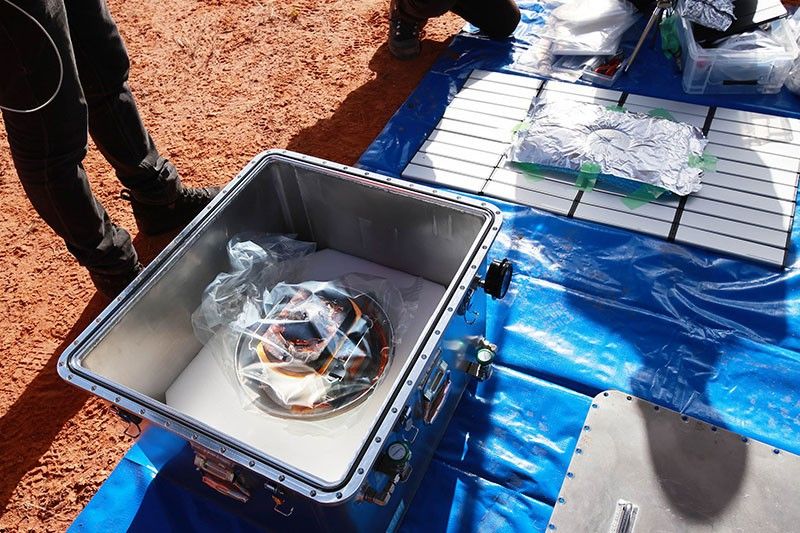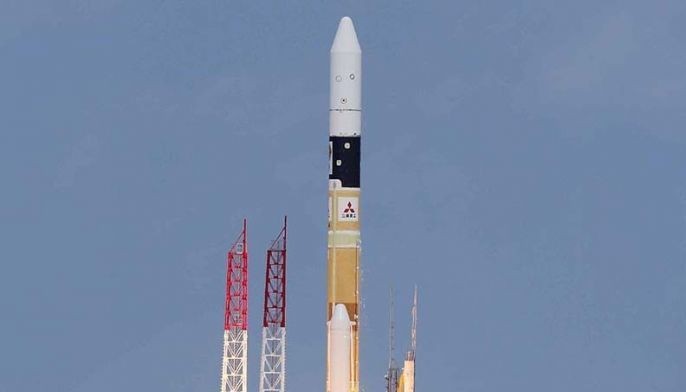Asteroid dust collected by Japan probe arrives on Earth

TOKYO, Japan — In a streak of light across the night sky, samples collected from a distant asteroid arrived on Earth Sunday after being dropped off by Japanese space probe Hayabusa-2.
Scientists hope the precious samples, which are expected to amount to no more than 0.1 grams of material, could help shed light on the origin of life and the formation of the universe.
The capsule carrying samples entered the atmosphere just before 2:30 am Japan time (1730 GMT Saturday), creating a shooting-star-like fireball as it entered Earth's atmosphere en route to a landing site in Australia.
"Six years and it has finally come back to Earth," an official narrating a live broadcast of the arrival said, as images showed officials from Japan's space agency JAXA cheering and pumping their fists in excitement.
A few hours later, JAXA confirmed the samples had been recovered, with help from beacons emitted by the capsule as it plummeted to Earth after separating from Hayabusa-2 on Saturday, while the fridge-sized probe was some 220,000 kilometres (137,000 miles) away.
"We found the capsule! Together with the parachute! Wow!" the mission's Twitter account announced.
People who had gathered at a public viewing site near JAXA's office in suburban Tokyo — despite the event taking place a few hours after midnight — also erupted with cheers.
"I'm extremely happy because the capsule has returned home safely, Hayabusa-2 did a great job," a primary school boy said.
The capsule was recovered in the southern Australian desert, and will now be in the hands of scientists performing initial, non-invasive analysis including checking for any gas emissions.
It will then be sent to Japan.
Samples with organic material?
The samples were collected by Hayabusa-2, which launched in 2014, from the asteroid Ryugu, some 300 million kilometres from Earth.
The probe collected both surface dust and pristine material from below the surface that was stirred up by firing an "impactor" into the asteroid.
The material is believed to be unchanged since the time the universe was formed.
Larger celestial bodies like Earth went through radical changes including heating and solidifying, changing the composition of the materials on their surface and below.
But "when it comes to smaller planets or smaller asteroids, these substances were not melted, and therefore it is believed that substances from 4.6 billion years ago are still there," Hayabusa-2 mission manager Makoto Yoshikawa told reporters before the capsule arrived.
Scientists are especially keen to discover whether the samples contain organic matter, which could have helped seed life on Earth.
"We still don't know the origin of life on Earth and through this Hayabusa-2 mission, if we are able to study and understand these organic materials from Ryugu, it could be that these organic materials were the source of life on Earth," Yoshikawa said.
"We've never had materials like this before... water and organic matters will be subject to research, so this is a very valuable opportunity," said Motoo Ito, senior researcher at the Japan Agency for Marine-Earth Science and Technology.
Half of Hayabusa-2's samples will be shared between JAXA, US space agency NASA and other international organisations, and the rest kept for future study as advances are made in analytic technology.
More tasks for Hayabusa-2
The work is not over for Hayabusa-2, which will now begin an extended mission targeting two new asteroids.
It will complete a series of orbits around the sun for around six years before approaching the first of the asteroids — named 2001 CC21 — in July 2026.
The probe will not get as close as it did to Ryugu, but scientists hope it will be able to photograph CC21 and that the fly-by will help develop knowledge about how to protect Earth against asteroid impact.
Hayabusa-2 will then head towards its main target, 1998 KY26, a ball-shaped asteroid with a diameter of just 30 metres.
When the probe arrives at the asteroid in July 2031, it will be approximately 300 million kilometres from Earth.
It will observe and photograph the asteroid, no easy task given that it is spinning rapidly, rotating on its axis about every 10 minutes.
But Hayabusa-2 is unlikely to land and collect samples, as it probably would not have enough fuel to return them to Earth.
Monitor major developments on space explorations and the status of missions.
NASA reveals a sample collected from the 4.5-billion-year-old asteroid Bennu contains abundant water and carbon, offering more evidence for the theory that life on Earth was seeded from outer space.
The discovery follows a seven-year-round-trip to the distant rock as part of the OSIRIS-REx mission, which dropped off its precious payload in the Utah desert last month for painstaking scientific analysis.
"This is the biggest carbon-rich asteroid sample ever returned to Earth," NASA administrator Bill Nelson says at a press event at the Johnson Space Center in Houston, where the first images of black dust and pebbles were revealed. — AFP
NASA is set to reveal on Wednesday the first images of the largest asteroid sample ever collected in space, something scientists hope will yield clues about the earliest days of our solar system and perhaps the origins of life itself.
The OSIRIS-REx mission collected rock and dust from the asteroid Bennu in 2020, and a capsule containing the precious cargo successfully returned to Earth a little over two weeks ago, landing in the Utah desert.
It is now being painstakingly analyzed in a specialized clean room at NASA's Johnson Space Center in Houston. — AFP
A Spanish company launches the country's first private rocket on Saturday in a step towards bringing Spain into the exclusive club of space-faring nations.
The launch of the small MIURA1 rocket took place at 02:19 am (0019 GMT) from a military base in the southern region of Andalusia, according to the company, PLD Space.
The company hailed the launch as "successful" and said it had achieved all its "technical objectives". — AFP
India's Sun-monitoring spacecraft has crossed a landmark point on its journey to escape "the sphere of Earth's influence", its space agency says, days after the disappointment of its Moon rover failing to awaken.
The Aditya-L1 mission, which started its four-month journey towards the centre of the solar system on September 2, carries instruments to observe the Sun's outermost layers.
"The spacecraft has escaped the sphere of Earth's influence," the Indian Space Research Organisation (ISRO) says in a statement. — AFP
Carbon dioxide detected on Jupiter's moon Europa comes from the vast ocean beneath its icy shell, research using James Webb Space Telescope data, potentially bolstering hopes the hidden water could harbour life.
Scientists are confident there is a huge ocean of saltwater kilometres below Europa's ice-covered surface, making the moon a prime candidate for hosting extra-terrestrial life in our Solar System.
But determining whether this concealed ocean has the right chemical elements to support life has been difficult. — AFP
- Latest




























